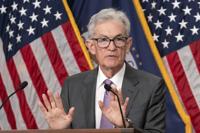WASHINGTON (AP) — Most Federal Reserve officials agreed last month that they would likely cut their benchmark interest rate at their next meeting in September as long as inflation continued to cool.
The minutes of the Fed’s July 30-31 meeting, released Wednesday, said the “vast majority" of policymakers “observed that, if the data continued to come in about as expected, it would likely be appropriate to ease policy at the next meeting.”
At the July meeting, the policymakers kept their benchmark rate at 5.3%, a near-quarter-century high, where it's stood since July 2023.
Wall Street traders had already considered it a certainty that the Fed will announce its first interest rate cut in four years when it meets in mid-September, according to . A lower Fed benchmark rate would lead eventually to lower rates for auto loans, mortgages and other forms of consumer borrowing and could also boost stock prices.
The minutes of the Fed’s meetings sometimes reveal key details behind the policymakers’ thinking, especially about how their views on interest rates might be evolving. Further guidance on the Fed’s next steps is expected when Friday morning at the annual symposium of central bankers in Jackson Hole, Wyoming.
Most analysts think Powell will signal in his speech that the Fed has become confident that inflation is headed back to its 2% target and might even give some hint about how many rate cuts could happen this year. When he held a news conference after last month’s Fed meeting, Powell had suggested that a broad range of policy moves were possible, from “zero cuts to several cuts,” by year’s end.
Two days after the Fed met late last month, the government released a that showed that hiring was far weaker than expected and that the unemployment rate rose for a fourth straight month, to a still-low 4.3%. The sluggish hiring data triggered a sharp two-day , with traders suddenly fearing that a recession might be nearing.
But last week, the government reported that sales at retail stores and restaurants in July, evidence that consumers were still willing to spend and help power the economy. And a separate report showed that the number of people seeking unemployment benefits — a proxy for layoffs — during the previous week, a sign that most businesses are still holding on to their workers.








































